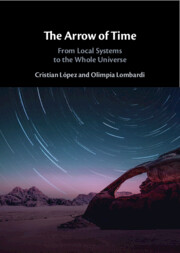Book contents
- The Arrow of Time
- The Arrow of Time
- Copyright page
- Contents
- Contributors
- Preface
- Acknowledgments
- Part I Local Systems
- Part II The Arrow of Time and Philosophical Issues
- 4 Explaining the Psychological Arrow of Time in Time-Symmetric Physics
- 5 The Consequence Argument Meets the Mentaculus
- 6 “Freedom from the Inside Out”: Revisited
- 7 The Arrow of Time Is Alive and Well but Forbidden under the Received View in Physics
- Part III The Arrow of Time and Time-Reversal Invariance
- Part IV The Whole Universe
- Index
- References
4 - Explaining the Psychological Arrow of Time in Time-Symmetric Physics
from Part II - The Arrow of Time and Philosophical Issues
Published online by Cambridge University Press: 28 October 2025
- The Arrow of Time
- The Arrow of Time
- Copyright page
- Contents
- Contributors
- Preface
- Acknowledgments
- Part I Local Systems
- Part II The Arrow of Time and Philosophical Issues
- 4 Explaining the Psychological Arrow of Time in Time-Symmetric Physics
- 5 The Consequence Argument Meets the Mentaculus
- 6 “Freedom from the Inside Out”: Revisited
- 7 The Arrow of Time Is Alive and Well but Forbidden under the Received View in Physics
- Part III The Arrow of Time and Time-Reversal Invariance
- Part IV The Whole Universe
- Index
- References
Summary
If the mental is physical, that is, if our experiences are physical features of the world, then in particular, our experience of temporal directionality (i.e., our experience of the direction of time, call it “the psychological arrow of time,” is a physical feature of the world, possibly of our brains. What kind of physical feature of the brain can the psychological arrow be? To explore this question, we first explain (briefly) what physicalism about the mind is. We argue very briefly that all forms of so-called non-reductive physicalism are dualism in disguise, and we propose instead a full-blown reductive physicalist theory of all the special sciences (called “Flat Physicalism”), including psychology. Flat Physicalism is a generalization of a reductive foundation of statistical mechanics, in which the notions of probability and entropy are deduced from mechanics (rather than being postulated), and therefore it is an especially convenient framework for studying the psychological arrow of time. There are three possible accounts of the psychological arrow, which we explore in the framework of Flat Physicalism. The first approach accepts that temporal directionality is a feature of the world, which is reflected in our experience. Unfortunately, all the existing attempts along these lines fail, in particular, the attempts based on postulating low entropy in the past. One reason for their failure is their employment of “typicality” arguments which are either a priori or circular. This first account also fails to explain how the direction of entropy increase is “sensed” in order to be reflected in our brains. We conclude that contemporary physics does not support this first option, and if one insists on there being a temporal directionality in the world “out there” (as it were), then one needs to change the fundamental principles of physics in a rather radical way. The second approach denies that the world is time-directed, but accepts that temporal directionality appears in our experience. In this case we need to reduce the experience of the psychological arrow of time to a nontemporal degree of freedom in the brain, and this has the radical implication that the psychological arrow is the fundamental arrow of time, and it explains what appears to be the arrow of time “out there,” rather than the other way around. The third approach denies not only that the world is time-directed, but also that we experience temporal directionality. This option is a version of “denialism” in the science and philosophy of mind, which is the view that first-person reports concerning the mental realm are not always reliable. Here the task is to explain the first-person reports in a different way (we do not address this third option in detail here and mention it only to complete the picture). The case of the psychological arrow of time turns out to be extremely important in contemporary science in two respects. If the first option is the case, then this exploration brings to the surface a huge lacuna in contemporary physics and the need for a radical change in it. If the second or third option is the case, then the arrow of time offers a unique case for studying the physics of the mind.
Information
- Type
- Chapter
- Information
- The Arrow of TimeFrom Local Systems to the Whole Universe, pp. 73 - 101Publisher: Cambridge University PressPrint publication year: 2025
References
Accessibility standard: WCAG 2.1 AA
Why this information is here
This section outlines the accessibility features of this content - including support for screen readers, full keyboard navigation and high-contrast display options. This may not be relevant for you.Accessibility Information
Content Navigation
Allows you to navigate directly to chapters, sections, or non‐text items through a linked table of contents, reducing the need for extensive scrolling.
Provides an interactive index, letting you go straight to where a term or subject appears in the text without manual searching.
Reading Order & Textual Equivalents
You will encounter all content (including footnotes, captions, etc.) in a clear, sequential flow, making it easier to follow with assistive tools like screen readers.
You get concise descriptions (for images, charts, or media clips), ensuring you do not miss crucial information when visual or audio elements are not accessible.
Visual Accessibility
You will still understand key ideas or prompts without relying solely on colour, which is especially helpful if you have colour vision deficiencies.
Structural and Technical Features
You gain clarity from ARIA (Accessible Rich Internet Applications) roles and attributes, as they help assistive technologies interpret how each part of the content functions.
